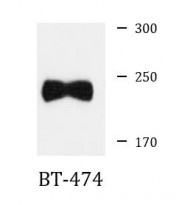ARG57800
anti-PHLPP1 antibody
anti-PHLPP1 antibody for ICC/IF,IHC-Formalin-fixed paraffin-embedded sections,Western blot and Human,Mouse,Rat
Overview
| Product Description | Rabbit Polyclonal antibody recognizes PHLPP1 |
|---|---|
| Tested Reactivity | Hu, Ms, Rat |
| Tested Application | ICC/IF, IHC-P, WB |
| Host | Rabbit |
| Clonality | Polyclonal |
| Isotype | IgG |
| Target Name | PHLPP1 |
| Antigen Species | Human |
| Immunogen | Recombinant fusion protein corresponding to aa. 1508-1717 of Human PHLPP1 (NP_919431.2). |
| Conjugation | Un-conjugated |
| Alternate Names | PHLPP; PH domain-containing family E member 1; Suprachiasmatic nucleus circadian oscillatory protein; PH domain leucine-rich repeat-containing protein phosphatase 1; Pleckstrin homology domain-containing family E member 1; hSCOP; EC 3.1.3.16; SCOP; PLEKHE1 |
Application Instructions
| Application Suggestion |
|
||||||||
|---|---|---|---|---|---|---|---|---|---|
| Application Note | * The dilutions indicate recommended starting dilutions and the optimal dilutions or concentrations should be determined by the scientist. | ||||||||
| Positive Control | BT-474 |
Properties
| Form | Liquid |
|---|---|
| Purification | Affinity purified. |
| Buffer | PBS (pH 7.3), 0.02% Sodium azide and 50% Glycerol. |
| Preservative | 0.02% Sodium azide |
| Stabilizer | 50% Glycerol |
| Storage Instruction | For continuous use, store undiluted antibody at 2-8°C for up to a week. For long-term storage, aliquot and store at -20°C. Storage in frost free freezers is not recommended. Avoid repeated freeze/thaw cycles. Suggest spin the vial prior to opening. The antibody solution should be gently mixed before use. |
| Note | For laboratory research only, not for drug, diagnostic or other use. |
Bioinformation
| Database Links | |
|---|---|
| Gene Symbol | PHLPP1 |
| Gene Full Name | PH domain and leucine rich repeat protein phosphatase 1 |
| Background | This gene encodes a member of the serine/threonine phosphatase family. The encoded protein promotes apoptosis by dephosphorylating and inactivating the serine/threonine kinase Akt, and functions as a tumor suppressor in multiple types of cancer. Increased expression of this gene may also play a role in obesity and type 2 diabetes by interfering with Akt-mediated insulin signaling. [provided by RefSeq, Dec 2011] |
| Function | Protein phosphatase involved in regulation of Akt and PKC signaling. Mediates dephosphorylation in the C-terminal domain hydrophobic motif of members of the AGC Ser/Thr protein kinase family; specifically acts on 'Ser-473' of AKT2 and AKT3, 'Ser-660' of PRKCB and 'Ser-657' of PRKCA. Isoform 2 seems to have a major role in regulating Akt signaling in hippocampal neurons (By similarity). Akt regulates the balance between cell survival and apoptosis through a cascade that primarily alters the function of transcription factors that regulate pro- and antiapoptotic genes. Dephosphorylation of 'Ser-473' of Akt triggers apoptosis and suppression of tumor growth. Dephosphorylation of PRKCA and PRKCB leads to their destabilization and degradation. Dephosphorylates STK4 on 'Thr-387' leading to STK4 activation and apoptosis. Dephosphorylates RPS6KB1 and is involved in regulation of cap-dependent translation. Inhibits cancer cell proliferation and may act as a tumor suppressor. Dephosphorylates RAF1 inhibiting its kinase activity. May act as a negative regulator of K-Ras signaling in membrane rafts (By similarity). Involved in the hippocampus-dependent long-term memory formation (By similarity). Involved in circadian control by regulating the consolidation of circadian periodicity after resetting (By similarity). Involved in development and function of regulatory T cells (By similarity). [UniProt] |
| Cellular Localization | Cell membrane, cytoplasm, membrane, nucleus, peripheral membrane protein. [UniProt] |
| Calculated MW | 185 kDa |
Images (1) Click the Picture to Zoom In






